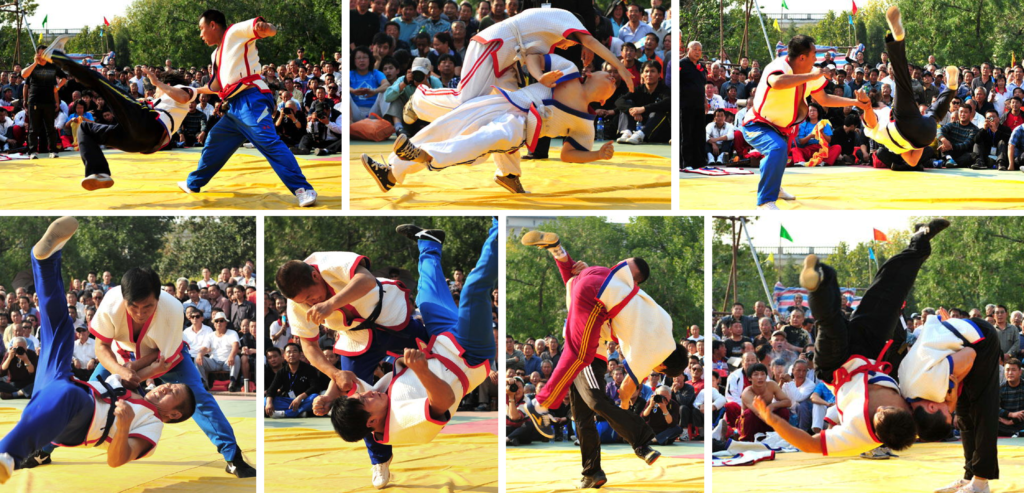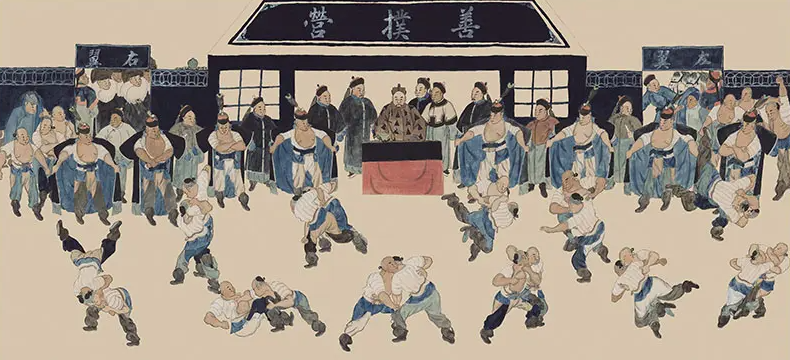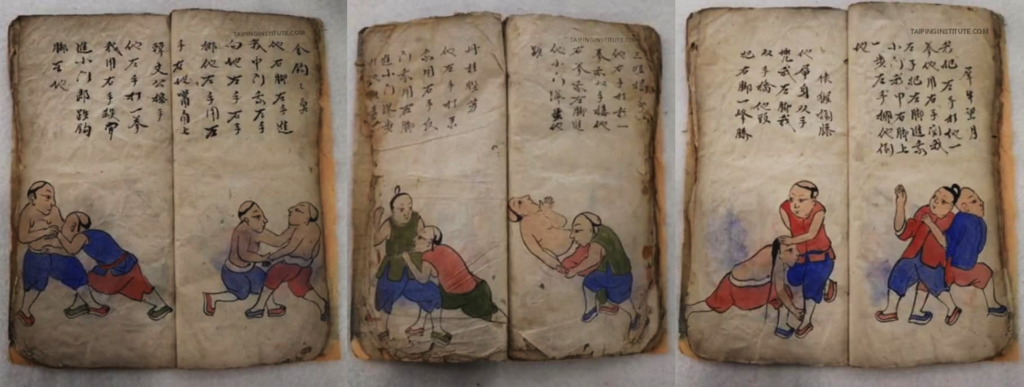
We introduce various categories of Combative Martial arts and combat sports. In many cases the foundation of both are interchangeable and more importantly in Classical Chinese martial arts most mater is holistic that is all aspects of combat need to be developed. Shuai Jiao (摔跤), commonly referred to as Chinese Wrestling has a long history when a type of wrestling known as Jiao Di was practiced during the Zhou Dynasty (1122-256 BC) and as the techniques continued to evolve they became known as Jiao Li (Strength Skill) (probably intended to describe a test of one’s strength). Jiao Li is mentioned in writing in the ancient classical text Li Ji (The Book of Rites). It was during this period that Jiao Li became a required part of military training along with archery, chariot riding and other military skills. As the style continued to evolve, certain strikes and joint-locking techniques were incorporated in its repertoire of skills.
During the Qin Dynasty (221-207 BC), Jiao Li gained widespread popularity and large contests were held to entertain the Imperial Court and to choose the best wrestlers, who were then lavishly rewarded for their skills. It has been recorded that some contests had well over a thousand participants who wrestled for several days, and at times up to a week, (a feat that is yet to be matched in modern times). The best wrestlers would often be assigned teaching posts for the Imperial family, be hired as bodyguards or gain advancement of rank in the military. The original translation for Shuai Jiao was “Throwing Horns.” Today, a new Chinese character has been adopted for Shuai which represents “Leg Tripping” or “Leg Wrestling” and is perhaps more descriptive of the art.
It is thought that Shuai Jiao is the predecessor of Japanese Ju-Jitsu and Judo (Outside Tokyo there is a monument in honor of Chen Yuanyun (1597-1671) who is thought to have brought grappling and wrestling skills (Shuaijiao) to Japan during the Ming Dynasty). Although the art consists primarily of throwing techniques, it also teaches kicking, striking, grabbing, and joint locking depending on the school and integration with combat skills taken. Shuai Jiao is a practical and realistic fighting art, since the practice match is essentially the same as actual combat. Training in Shuai Jiao makes one better prepared for a street confrontation. Shuai Jiao relies on highly developed sensitivity, the redirecting of an incoming force, and unbalancing tactics to apply throwing techniques. Since it does not rely on brute force, this is an excellent method for both men and women, and is especially fun for children to practice.

In the North there is the saying “Jing youzi, Wei Zuizi, Baoding GouTuizi” describing the key features of Shuaijiao practitioners across Beijing, Tianjin and Baoding. After the Qing Emperor Kangxi established Shan Pu Ying (Xiang Pu Ying), which is a great story in itself. Over generations this remained practice within the imperial guards, inviting the best far and wide to compete.
Afterwards they retired and became a part of society. There they taught across the Northern central plains, and the features across the three areas (there are others of course) most well known as: Beijing are difficult to grasp, slippery to get away, almost as if they are oiled up (Jing You zi). In Tianjin before their challenge they would place a nail in their mouth (Wei Zui zi), whereas Baoding known for their hooking legs (Gou Tui zi).

Shuaijiao is a component of many of our martial arts, integrated into combat. Especially of the Northern systems such as Cangzhou Da Liuhe Men and Baoding Chuojiao Men. GM Tong Zhongyi was known as “King of Wrestling” during his time and had codified a systematic approach to achieving Shuajiao skills establishing the Wrestling Society in Shanghai. Since GM Tong Zhongyi had studied Mongolian methods from his martial uncle, Manchurian methods from his father and Baoding methods whilst in Baoding (Cao Kun’s academy), it encompasses the essence of Shuajiao.
